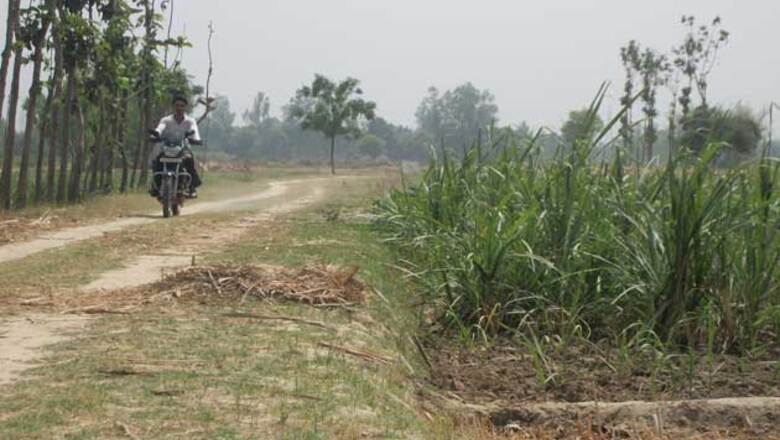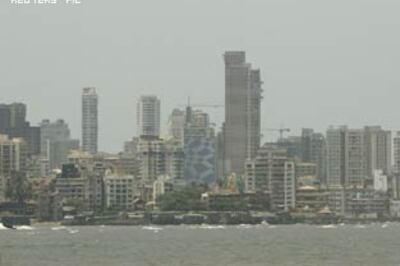
views
Spiralling sugar prices this season may have left behind a bitter tastes for many, but 41 lakh sugarcane farmers in Uttar Pradesh’s sugarcane belt are not complaining. More than Rs 7, 000 crore extra capital has got pumped into the rural economy in the last quarter as sugar mills jostled and brought cane at a premium to meet the demand-supply gap.
A livid April sun had imposed a curfew-like silence in an otherwise overcrowded Lal Bahadur Shastri Chowk when I met Janam Jay Singh in downtown Gonda.
Singh works as a sales executive with an automobile agency catering primarily to the rural segment. Upon being requested by a common acquaintance, he had agreed to be my guide for a day in this rural town a hundred km north-east of Lucknow.
“Sorry to have bothered you at this ungodly hour. You aren’t keeping well?” I inquired, noticing a distinct yellow tone in his eyes; those preliminary signs of a liver malfunction.
We got talking. He told me his clientele is mostly medium and large farmers of Gonda and Balrampur districts in the water-sufficient sugar cane belt of Uttar Pradesh running almost parallel to the Nepal border
“The business must be good after a bumper cane crop and a fairly reasonable remuneration to the farmers this season”; I enquired to get the conversation going.
“Too good for comfort, too good to keep me on my toes even if I am looking with a jaundiced eye”; he retorted. The pun, obviously, was unintentional.
Singh, in the last one month has sold twenty one vehicles including some high end SUVs and MUVs. For this year, sales are up by as much as 50%.
These are encouraging figures; so why is he bothered?
In a market where every vehicle loan translates into an extra cut- right from the sales man to the dealer- very few customers are getting their vehicles financed through banks.
Instead, they are paying in cash. Hard cash and down payment is what Janam Jay Singh is getting for nearly half of the twenty vehicles he has sold in the first month of this financial year.
Irrespective of the mode of payment, this spurt in automobile sale has set cash registers ringing in the sugarcane rich belt of Uttar Pradesh bordering Nepal.
Amit Auto Sales are the sole distributors of Mahindra’s Light Motor Vehicles in six districts around Faizabad. For the year ending 31st of March, 2010 sixty percent more vehicles have rolled out of their showroom as compared to the preceding one. The last quarter especially, has been exceedingly good.
Two wheeler agencies are a step ahead in sales. Ravi Automobile at Inayatnagar -- a taluka place or a tehsil on the Sultanpur-Faizabad border -- has sold more than 2,500 vehicles year, a hundred percent YoY increment.
Fuelled primarily by the rural market, all major two-wheeler manufactures have recorded exponential growth. In UP and Uttarkhand, 28 percent more units have been sold in 2009-10, that’s almost double the percentage growth registered by the segment in these areas last year.
The real impetus has been provided by a bumper sales in the last quarter (the sugarcane season) with Bajaj Auto now reporting a record 309 percent jump in profits as compared to the same quarter of the last financial year.
“The real surge would be witnessed when the marriage season begins in the second week of May,” says Umesh Pathak of the Narendra Dev Agricultire University at Kumargunj.
Cane and up
In Uttar Pradesh, 128 operational mills in 47 cane-growing districts of the state crush eight-lakh tones sugarcane every day during the peak season. For this year, the figures pouring into the state cane commissioner’s office in Lucknow indicate a two-fold increase in the remuneration to 41 lakh farmers. Almost thirteen thousand crore rupees have already been paid- that’s seven thousand more than last year.
So much so, that it has engendered sharp differences in Mahavir Singh’s large joint family in Gonda. His son has fallen for the latest model of Mahendra Xylo; but others are insisting on a grey Toyota Innova.
It’s a growth story triggered by an increase in the buying capacity of the agrarian class has triggered a growth with a much deeper percolation and a wider horizontal spread. It’s a stimulus of sorts, with government not having to spend a penny.
With cane selling over Rs 250 per quintal for most part of the crushing season, the income generated not only resuscitated the dying sugar industry in central UP, it has unleashed a concomitant growth no government package could possibly stimulate.
But mind you, it has to be both fair and remunerative.
Fair and remunerative
Under an aging sterile mango tree at the forecourt of his recently renovated pucca house, advocate C P Singh gets his daily diet of political gossip from a steady stream of visitors. Amidst mundane chitchat interspersed with numerous rounds of syrupy white stewed tea; his guests admire the new Medium Utility Vehicle or MUV purchased by the Singh family.
The household owns about 500 bighas in village Ashokpura on the Gonda-Faizabad highway. This year the family harvested over 9,000 quintals of sugarcane, selling the produce over Rs. 240/quintal to pocket a neat profit.
“It’s been an exceptionally good season. Last year we dumped cane at a throwaway price, incurring a huge loss,” he says.
That brings us to the moot question of determining the production cost of the cash crop; and the corresponding remuneration to the farmer for him to at-least break even at the end of the season?
Cost of production of sugarcane crop has for been a bone of contention between the agrarian class and the government for long. The mode and process of evaluation and fixing of the minimum support remuneration of any crop has been vociferously contested.
“Cost evaluation is a complicated process. But taking into account various factors including rise in labour cost, diesel prices etc; per quintal production cost of sugarcane is somewhere between 140 to 150 rupees per quintal,” says J P Mishra, an economist with the Narendra Dev Agriculture University in Faizabad.
That’s close to the sugarcane fair and remunerative price, or the FRP, announced by the government for the next season. But there are others who are rubbishing these figures.
Kisaan Jagran Manch, a non-political platform of professionals and intellectuals working on agricultural issues, claims that in Muzaffarnagar, the heart of western UP’s cane belt, per quintal cost (average of plant and ratoon) would be close to Rs 216.
“The cost of the farmer’s produce is decided by the government. Even when market forces help him to fetch higher prices, as it happened this year, government would immediately intervene to his detriment,” says Sudhir Pawar of the Manch
.
Sugarcane pricing
Sugarcane prices in India have shown a cyclical patter. The current cycle began with the glut year 2006-07 when sugarcane production shot up to a whopping 46 percent on YoY basis. With farmers not getting a fair deal for two consecutive years, there was a sharp decline in sugar cane acreage and production in 2008-09 (14.7 million tones) causing a 50 percent increase in the wholesale prices of sugar the corresponding year.
In UP- that is the second largest producer of cane after Maharashtra- the year 2009-10 was marked by a nadir in cane farming with the cropped area declining to 17.88 lakh hectares.
This shortfall- both in sugarcane acreage and sugar production- compounded by pressures in the international markets propelled cane price to a record high in western UP this season.
Even in Poorvanchal and central parts of UP, sugar mill had to shell out as much as Rs 260 per quintal. This was almost the double of what the government announced as the benchmark price under the new Fair and Remunerative price regime for sugarcane.
As a result, this year, sugar production in UP has already touched 51.50 lakh tones, an increase of 30 percent over last year
Enthused by remuneration, and a better yield per acre (the UP state agriculture department is reporting 900 quintal/ hectare for this year- almost 50% more than 2008-09); farmers are rushing to capitalize on the manna with state government estimating a 20% increase in sugarcane acreage for the next season.
How does this bode for the sugarcane farmer rushing in where they feared to tread a few years back?
Small and marginal
“2010-11 in all likelihood would be a cane surplus year,” warns Dr Sudhir Pawar of Kisaan Jagran Manch.
His words ring true in the same Ashokpura village, not far away from where Advocate C P Singh holds his daily durbar.
Ram Bahadur Singh is a small farmer who owns just 26 bighas of land. For the last three years he has focused on paddy and vegetables, consciously reducing sugarcane acreage to offset downslide in sugarcane prices.
“Cash crop requires far greater investment including greater labour inputs,” says Ram Bahadur offering me a slice of green sweet-n-sour mangoes strewn all around in the last evening squall.
“I have been growing just 2 to 3 bighas of cane; that too for domestic consumption only,” he says.
The bumper yield and remuneration this year has lured farmers, especially the likes of Ram Bahadur, to fall back once again upon sugarcane.
Uttar Pradesh alone is reporting an increase of 20 percent in sugarcane acreage for the year 2010-2010.
Sugar prices this year have already peaked. India had already had sufficient sugar production. The other two big international producers Brazil and Thailand will soon be offloading their produce in market leading to further stabilization in sugar prices both domestically and internationally.
What could add to his woes is the government intervention to check sugar prices as a part of the larger effort to control spiraling inflation.
Intervention
The crushing season for the year 2009-10 was delayed by almost a month with farmers and mill-owners wrangling over the Fair and Remunerative Price Regime. The matter was settled only in November after the parliament convened for the winter session.
At that time, markets were riding high on a sentiment that there was a dearth of sugarcane both in the domestic and international markets. This demand supply mismatch was further given currency by government agencies reporting a shrinking sugarcane footprint in all the major sugarcane producing states in the country.
What added grist to the mill was Brazil’s tactical move to divert a substantial chunk of the produce for ethanol production in the last two years - creating enough shortfalls in the international market leading up to a sharp prices escalation.
All these factors cumulatively led to farmer getting a fair deal in early part of the season.
And then the government intervened.
In the third week of February when Parliament met for the budget session, the Opposition’s clamour against skyrocketing prices of essential commodities was getting shriller. Prime Minister Manmohan Singh immediately called for a meeting of Chief Ministers and sought corporation from the states.
A slew of measures followed to check inflation. One of the first steps taken by the government was to facilitate sugar imports by lifting of duties. Bulk users which consume between 60 to 70 percent of the stock were allowed to raw sugar from the international markets.
The policy inflection had an instant effect- felt right the gates of the mills rushing in with some late season purchase before closing shops for the year.
“Our landed cost of sugar which will arrive in July is Rs.35 per kg. Prices of sugar have almost touched Rs.26 per kg while my manufacturing cost is Rs.29/30 per kg”, says Rajshree Pathy, President of Indian Sugar Mills Association.
In Shamli, the heart of the vast sugarcane producing plains in the Ganga-Yamuna basin, by April farmers were finding it hard to sell whatever remained of their crop.
“Nearly 7% of the area is un-harvested. We were expecting prices to rise further up to Rs300 per quintal towards the season end”; complained a farmer standing at the mill gate for almost eight hours since five in the morning to sell his produce.
The wait next year could be a trifle longer.
(CNN-IBN's Sumit Pande is doing a series of reports on small/marginal farmers and denotified tribes. The series is funded by Inclusive Media for Change, or im4change, of the Centre for the Study of Developing Societies.)




















Comments
0 comment